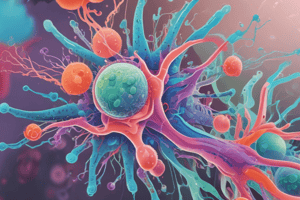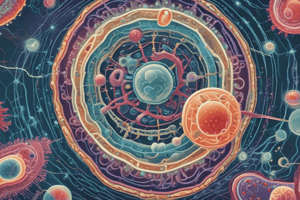Podcast
Questions and Answers
What is the primary function of the cell wall in bacteria?
What is the primary function of the cell wall in bacteria?
- To maintain cell turgor pressure and provide shape (correct)
- To translate messenger RNA into amino acid sequences
- To regulate the flow of nutrients and waste
- To store genetic information
What is the main component of the bacterial cell membrane?
What is the main component of the bacterial cell membrane?
- Phospholipid bilayer (correct)
- Peptidoglycan
- DNA
- Protein filaments
What is the function of the nucleoid region in bacteria?
What is the function of the nucleoid region in bacteria?
- To regulate cell signaling
- To synthesize proteins
- To store genetic information (correct)
- To maintain cell turgor pressure
What is the purpose of ribosomes in bacterial cells?
What is the purpose of ribosomes in bacterial cells?
What is the function of flagella in bacterial cells?
What is the function of flagella in bacterial cells?
What is the primary function of inclusion bodies in bacterial cells?
What is the primary function of inclusion bodies in bacterial cells?
What is unique about the cell wall of Gram-positive bacteria?
What is unique about the cell wall of Gram-positive bacteria?
What is the function of the cytoplasm in bacterial cells?
What is the function of the cytoplasm in bacterial cells?
What is the difference between the nucleoid region in bacteria and the nucleus in eukaryotic cells?
What is the difference between the nucleoid region in bacteria and the nucleus in eukaryotic cells?
What is the function of peptidoglycan in bacterial cells?
What is the function of peptidoglycan in bacterial cells?
Flashcards are hidden until you start studying
Study Notes
Cell Structure of Bacteria
Cell Wall
- Rigid layer outside the cell membrane, providing shape and support
- Composed of peptidoglycan (also known as murein), a unique molecule found only in bacteria
- Thickness varies between species, with Gram-positive bacteria having a thicker wall than Gram-negative bacteria
Cell Membrane
- Semipermeable membrane that separates the cell from its environment
- Composed of a phospholipid bilayer with embedded proteins
- Functions:
- Regulates the flow of nutrients and waste
- Maintains cell turgor pressure
- Involved in cell signaling and communication
Cytoplasm
- Jelly-like substance inside the cell membrane
- Composed of water, salts, sugars, and various organelles
- Functions:
- Site of metabolic reactions
- Supports the cell's genetic material (DNA)
Nucleoid
- Region of the cytoplasm where the bacterial DNA is found
- Not a membrane-bound organelle, unlike the nucleus in eukaryotic cells
- Functions:
- Stores genetic information
- Replicates during cell division
Ribosomes
- Small organelles found throughout the cytoplasm
- Responsible for protein synthesis
- Functions:
- Translate messenger RNA (mRNA) into amino acid sequences
- Assemble amino acids into polypeptide chains
Flagella
- Long, whip-like structures used for movement
- Composed of protein filaments
- Functions:
- Enable bacteria to move towards or away from stimuli
- Important for colonization and infection
Inclusion Bodies
- Membrane-bound organelles that store nutrients or waste
- Functions:
- Store carbon, nitrogen, or phosphorus sources
- Help maintain cellular homeostasis
Cell Structure of Bacteria
Cell Wall
- Provides shape and support to the cell
- Composed of peptidoglycan (murein), a unique molecule found only in bacteria
- Thickness varies between species, with Gram-positive bacteria having a thicker wall
Cell Membrane
- Semipermeable membrane that separates the cell from its environment
- Composed of a phospholipid bilayer with embedded proteins
- Regulates the flow of nutrients and waste
- Maintains cell turgor pressure
- Involved in cell signaling and communication
Cytoplasm
- Jelly-like substance inside the cell membrane
- Composed of water, salts, sugars, and various organelles
- Site of metabolic reactions
- Supports the cell's genetic material (DNA)
Nucleoid
- Region of the cytoplasm where the bacterial DNA is found
- Not a membrane-bound organelle
- Stores genetic information
- Replicates during cell division
Ribosomes
- Small organelles found throughout the cytoplasm
- Responsible for protein synthesis
- Translate messenger RNA (mRNA) into amino acid sequences
- Assemble amino acids into polypeptide chains
Flagella
- Long, whip-like structures used for movement
- Composed of protein filaments
- Enable bacteria to move towards or away from stimuli
- Important for colonization and infection
Inclusion Bodies
- Membrane-bound organelles that store nutrients or waste
- Store carbon, nitrogen, or phosphorus sources
- Help maintain cellular homeostasis
Studying That Suits You
Use AI to generate personalized quizzes and flashcards to suit your learning preferences.




